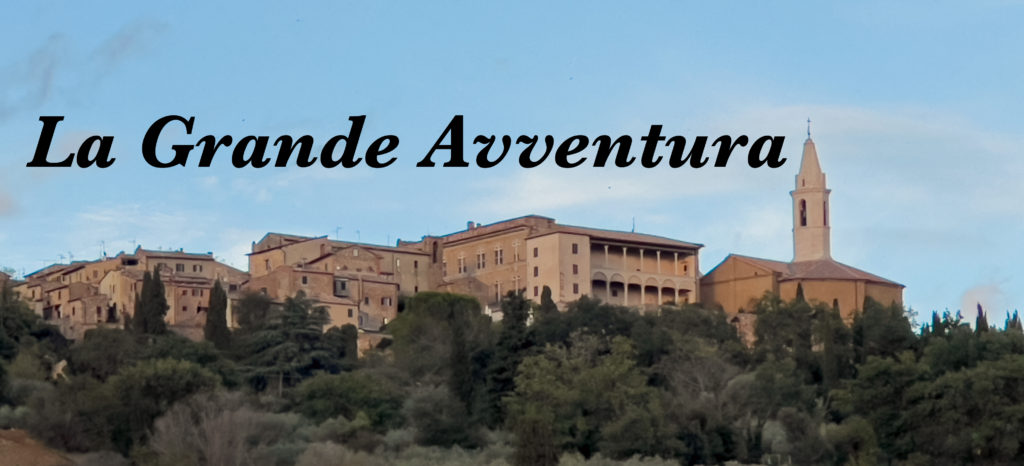
On their way back from Pienza to Seattle, Carol and Roger stopped over in Ireland for 10 days of sightseeing.
Dublin…with a quarter the population of Ireland…was quaint but was like any other big city.
One pleasant surprise was the pub scene. Irish pubs are friendly and welcoming (except for the one tourist trap we visited) with good food (delicious fish and chips…every bit as good as Iceland’s) and, of course plenty of Guinness.


Heading out of Dublin, Carol and Roger found more and more of the signage in Gaelic…This bar in Dingle is named “The Courthouse Pub.” We know this not because we became suddenly fluent in Gaelic, but because the name was written in English on the other side of the building.
The small towns in the countryside are as charming as picture postcards.


The physical geography is something else. The west coast of Ireland is called the Wild Atlantic…for good reason.
When George Lucas was looking for an otherworldly location to film scenes for Return of the Jedi, here’s where he chose.
When Sir Francis Drake scattered the Spanish Armada off the coast of England in 1588, the Spanish fleet tried to re-group off Ireland’s Atlantic Coast. The wild weather and the rocky shoreline drove many of the warships aground, drowning hundreds of Spanish sailors.


The winds were so strong at the Cliffs of Moher…40 mph…Carol had to hang on for dear life to keep from being blown over the edge.
July is supposed to be one of Ireland’s drier months. Carol and Roger spent their day on the Cliffs of Moher watching the rain squalls roll in. In fact, they sat through
- 11 rainstorms on Monday
- 5 rainstorms on Tuesday
- 4 rainstorms on Wednesday
- 1 rainstorm on Thursday…all day.


Carol and Roger crossed the Shannon River estuary on a small catamaran ferry….to the Dingle Peninsula.
The Dingle Peninsula is just as wild as the Galway coast. Had this lighthouse been built back in the days of the Spanish Armada, perhaps the four ships that got blown onto the rocks on this peninsula could have avoided their fate.


Off the western tip of the Dingle Peninsula lie the Blasket Islands…the western-most speck of land in Europe. The Blaskets are so remote and desolate that in 1953 the Irish government forced the few remaining residents to relocate to the mainland.
The Dingle Peninsula contains many Lios…or prehistoric forts built by the Druids for protection and family housing. This particular one is called Cashel Murphy…and dates back 5300 years (3200 BCE).
One family lived in each of the circular openings (called beehive huts), which…more than a millenia ago…had stone roofs.


The countryside of western Ireland is littered with castles. This is Rahinane Castle, County Kerry, built in 686. Like most of the castles we saw in Ireland, it was abandoned and allowed to deteriorate.
The castles we saw tended to differ from the castles of Italy in several ways. Italian castles were built around a central square that was a hub for village economic activity, while Irish castes tended to be towers. Italian castles were built on a hilltop and surrounded by a moat…while Irish castles were right on the shoreline, designed to protect the coast.


A few of the castles we saw…like this Norman tower in Gallarus, County Kerry…were undergoing restoration. Sadly, most were not.
The exception that proves the rule is Kylemore Abbey in County Galway. It was built by the Benedictine monks during WW I to house Belgian nuns displaced by the war. It still operates as a monastery today.


Even Ireland’s most famous castle…Blarney Castle, just outside of Cork…was in a state of deterioration. Built in 1446 as the home of the McCarthy clan, it sits on expansive grounds with beautiful gardens and fully restored out-buildings.
And for a fee….one can climb to the top of the castle and kiss the Blarney Stone.


Ireland certainly has its share of beautiful churches…like the Cork Cathedral.
Or the stunningly vertical Cathedral in Cobh.

The most primitive church… the Gallarus Oratory…was in County Kerry. It’s a national archeological site because of its unique sloping-walled, corbel architecture.


The church in Kilmalkedar was first built in 636. It’s been long abandoned, though the graveyard contains the bodies of local folk recently deceased.
Roger’s favorite church, however, is known as the home of St. Brendan the Navigator. Local legend says Christopher Columbus visited County Kerry in 1477, learned that St. Brendan had sailed from Ireland to Newfoundland in the 6th century CE…which planted the seed for Columbus’ “discovery” of the New World in 1492.


In western Ireland, sheep are everywhere. Sheep in the pastures…
…Sheep who wander onto the roads…


Carol even got to feed a baby lamb.
But yarn….to Carol’s surprise…was much harder to find. Wool Shops were everywhere. Most sold mass-produced Irish-knit sweaters aimed at tourists. After disappointing visits to 8 shops across Ireland…

Finally, in Kilkerry, Carol finally hit pay-dirt. She found Kerry Mills, one of the few remaining mills that produces everything from fleece to sweaters…
…and she left a happy camper.

